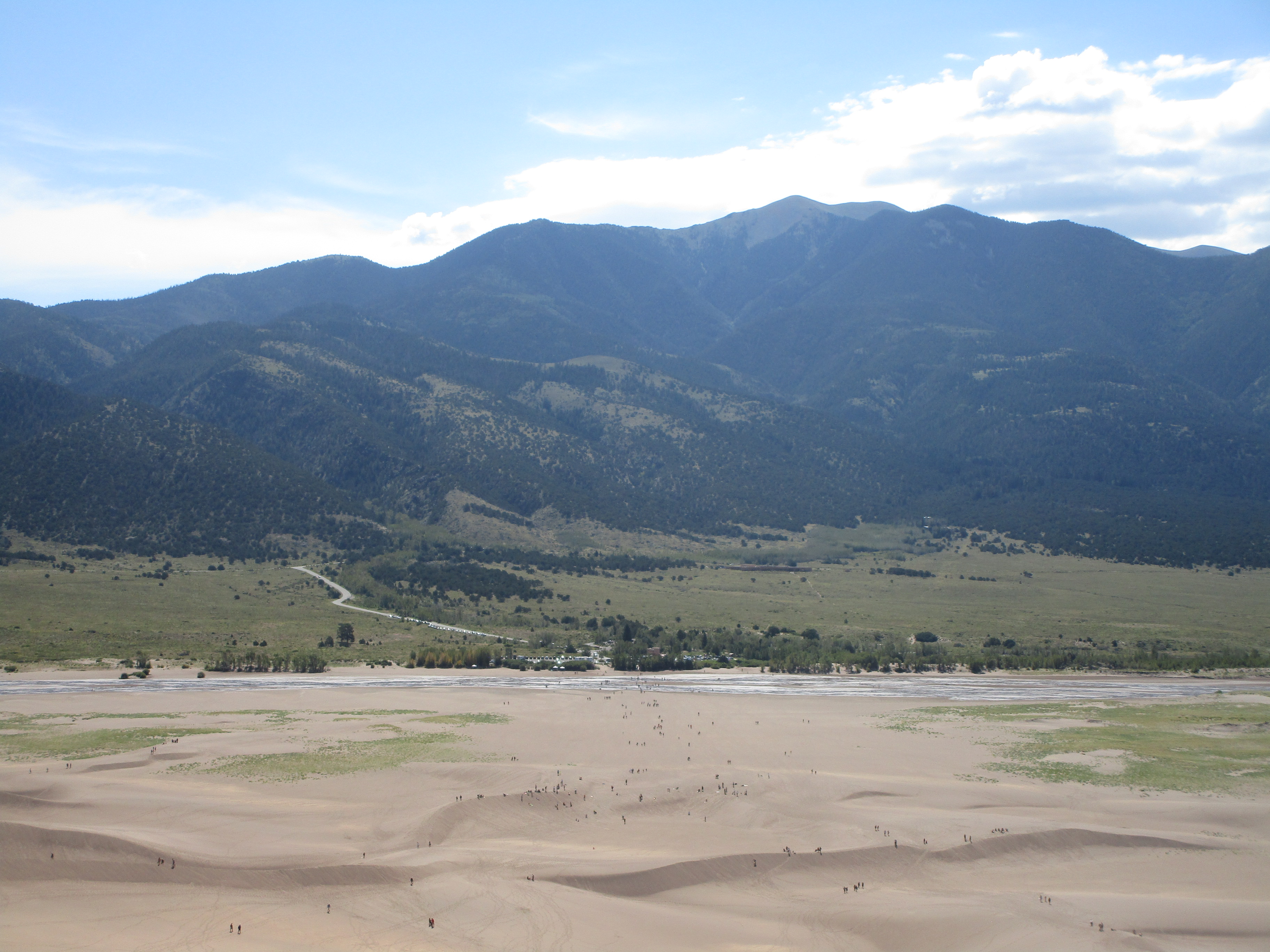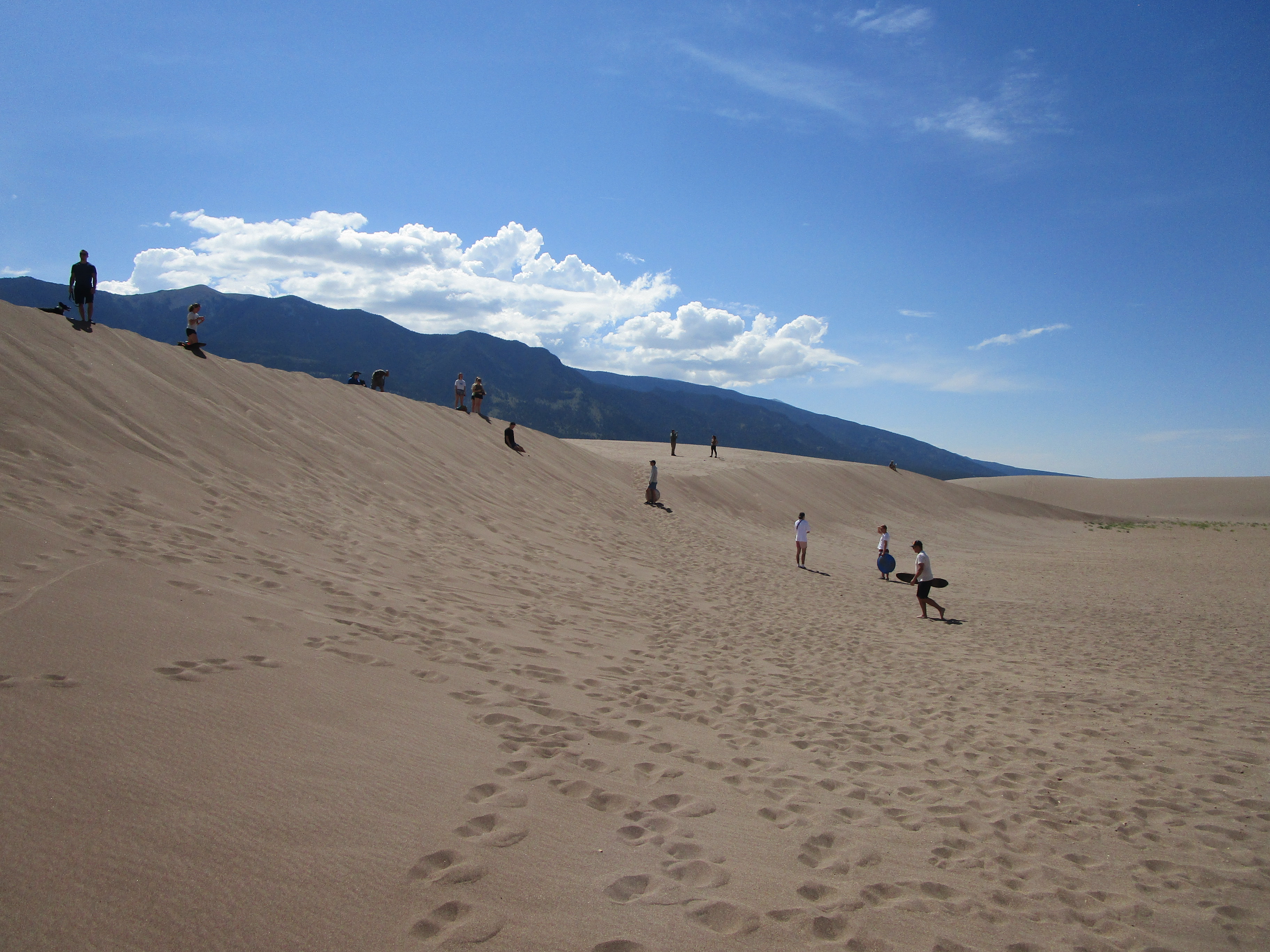Great Sand Dunes National Park, situated in south-central Colorado, is home to the tallest sand dunes in North America. These sand dunes are tucked away in a valley surrounded by tall mountains. Medano Creek, a trickle of a stream through the sand, flows alongside the dunes. Visitors will have fun by using sleds and snowboards adopted for use on the sand hills. Hikers will seek to climb to the summit of the tallest dunes. The water flowing alongside the dunes creates the only situation in Colorado where sand meets the water; thus, the park is dubbed "Colorado's only natural beach".
Here's what the dunes look like from a distance, as you're approaching the park from the south:
Here's what the dunes look like from a distance, as you're approaching the park from the south:
Here's Medano Creek. I was trying to figure out what this shallow trickle of water was, and it turns out that this is the highly unusual Medano Creek. The creek becomes a rushing river in the spring, as the winter snows begin to melt. The creek was very shallow, though, running over sand in a way that reminds you of a beach lining a proper shore.
The cooler, wet sand is a much-needed respite for those whose feet will touch the hotter dry sand of the dunes. Be warned: the sand will reach 150 degrees Fahrenheit in the afternoon, so the best course of action is to hike the dunes early in the morning. Crossing the water is a requirement to get from the parking lot to the sand dunes.
The views of the mountains to the north and west get a little nicer as you make your way up the sand. If you've ever walked on a beach, though, you understand that walking through sand is much more strenuous than walking on hard ground. You also likely understand that hiking upward is more strenuous than walking on flat land. Combine the sandy terrain with uphill travel and you will realize that hiking up a sand dune is very difficult and taxing on the body. Even worse, the park sits at about 8,000 feet above sea level. I decided that, even though hiking up a sand dune at a high elevation was really difficult, I was going to use the sand sled that I rented at the Oasis shop down the road, darn it!
There is no particular trail provided for people hiking on the dunes. You walk wherever you want. My goal was to find a path that would get me up to where I wanted without causing extra strain on my body. It's going to be a strenuous hike no matter what, though, because every step causes your foot to sink into the sand. All that sinking has to be compensated for by climbing back out of the footprint you created yourself. Every uphill step causes you to slide backward somewhat; that has to be compensated for, too.
I made it most of the way up the High Dune, and look! The people look like ants from up here!
The Oasis shop, which rented me the board, provided me with some board wax to ensure smooth sailing. Wax the bottom of your board by making a zigzagging motion. Ensure you have a steep enough slope to careen downward, ideally along a path with as few footprints as possible. Lots of people had face masks to keep the sand from kicking back into their face as they sled down. I definitely ended up understanding why they wore those. Well, here goes nothing!
Now I'm back at the bottom.
Visiting in the warm season's afternoons is not advised, as the sand reaches harmful and uncomfortably hot temperatures. We spent the afternoon exploring the trail to Zapata Falls, home to water which, ironically, felt ridiculously cold on my feet. Zapata Falls and the associated trail are not within Great Sand Dunes National Park; rather, they are about ten miles to the south.
Count: Great Sand Dunes NP was the 20th national park we've visited.
Back to the national parks main page.
Back to the home page.
Count: Great Sand Dunes NP was the 20th national park we've visited.
Back to the national parks main page.
Back to the home page.










